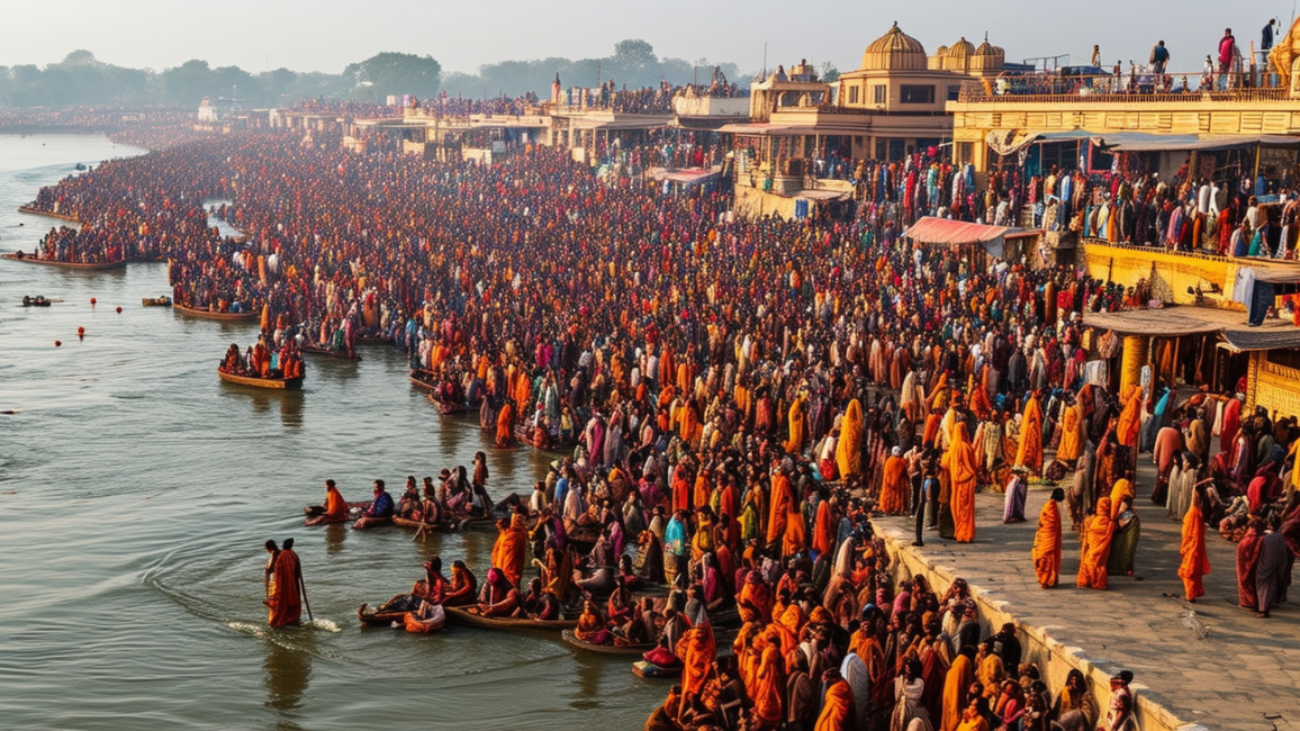Dive into the rich history Of Kumbh Mela, exploring its evolution, significance, and cultural impact from ancient times to the modern era.
The Mythological Origins of Kumbh Mela

The origins of Kumbh Mela are deeply rooted in Indian mythology. According to ancient texts, the gods and demons once churned the ocean to obtain the nectar of immortality. During this celestial event, known as the Samudra Manthan, drops of this sacred nectar fell at four locations on Earth: Prayagraj, Haridwar, Nashik, and Ujjain. These places became the sites for the Kumbh Mela.
This mythological backdrop provides the spiritual foundation for the Kumbh Mela, attracting millions of devotees seeking purification and blessings. The festival is not just a religious gathering but a manifestation of faith and spirituality that has endured for millennia.
Ancient Traditions and Rituals: A History Of Kumbh Mela

The Kumbh Mela is characterized by its ancient traditions and rituals, some of which date back thousands of years. Pilgrims partake in the ritual bathing in sacred rivers, which is believed to cleanse them of sins and grant them spiritual merit. The timing of these baths is determined by precise astrological calculations, ensuring that the events align with auspicious planetary positions.
In addition to the ritual baths, History Of Kumbh Mela features a variety of religious ceremonies, discourses, and cultural performances. Sadhus and ascetics from diverse sects gather to engage in spiritual discussions, making the festival a melting pot of religious and philosophical ideas.
Kumbh Mela Through the Ages: Evolution and Transformation
Throughout History Of Kumbh Mela, the Kumbh Mela has evolved and transformed, reflecting the changing socio-political landscape of India.
Medieval Period: The Rise of Naga Sadhus – During the medieval period, the Kumbh Mela saw the rise of Naga Sadhus, militant ascetics who played a crucial role in protecting the Hindu religion. These warrior monks became a prominent feature of the festival, showcasing their martial prowess and spiritual discipline.
Colonial Period: The Mela as a Symbol of Unity – Under British colonial rule, the Kumbh Mela emerged as a symbol of unity and resistance. It became a platform for Indian leaders to mobilize the masses and promote nationalist ideals. The festival’s significance extended beyond religious boundaries, embodying the spirit of collective identity and cultural pride.
The Modern-Day Kumbh Mela: A 2025 Perspective
In 2025, the Kumbh Mela continues to be a vibrant and dynamic event, blending tradition with modernity. Advances in technology and infrastructure have transformed the logistics of the festival, making it more accessible and organized. Digital platforms now provide real-time updates, virtual tours, and online religious services, allowing a global audience to participate in the festivities.
However, despite these modern advancements, the core essence of the Kumbh Mela remains unchanged. It remains a deeply spiritual experience, where millions gather to seek solace, enlightenment, and a sense of community.
Cultural Significance and Global Impact
The History Of Kumbh Mela holds immense cultural significance, serving as a repository of India’s rich heritage and traditions. It is a celebration of art, music, and literature, with performances and exhibitions that showcase the country’s diverse cultural landscape.
On a global scale, the Kumbh Mela has garnered international attention, attracting scholars, tourists, and spiritual seekers from around the world. Its recognition as a UNESCO Intangible Cultural Heritage of Humanity highlights its universal value and the role it plays in promoting cultural dialogue and understanding.
The Role of Kumbh Mela in 2025: A New Era of Connection

In 2025, the Kumbh Mela is not just a religious festival but a platform for fostering connections and building bridges. It provides an opportunity for people from different backgrounds and cultures to come together, share experiences, and learn from one another. The festival’s inclusive nature promotes harmony and mutual respect, transcending religious and cultural boundaries.
As the world becomes increasingly interconnected, the Kumbh Mela serves as a reminder of the importance of preserving traditions while embracing change. It exemplifies how cultural heritage can be a source of unity and inspiration in a rapidly evolving world.
Kumbh Mela as a Living Tradition
The History Of Kumbh Mela is a living tradition, continuously adapting to the changing times while remaining rooted in its spiritual essence. It is a testament to the enduring power of faith and the resilience of cultural practices. Each iteration of the festival adds new layers of meaning and significance, enriching the collective memory of those who participate.
As we look to the future, the Kumbh Mela will continue to thrive, offering a sanctuary for spiritual exploration and a celebration of humanity’s shared heritage. It stands as a beacon of hope, reminding us of the timeless values that unite us all.
Conclusion
The history of Kumbh Mela is a rich tapestry woven with threads of mythology, tradition, and transformation. From its ancient origins to its modern-day manifestations, the festival has remained a cornerstone of spiritual and cultural life in India.
As we explore the Kumbh Mela from a 2025 perspective, we recognize its enduring significance and its role in shaping a more connected and harmonious world. The Kumbh Mela is not just a historical event but a living tradition that continues to inspire and uplift millions, transcending the boundaries of time and space.


